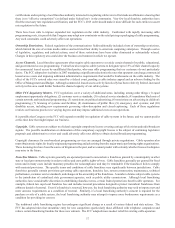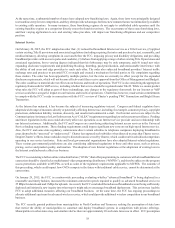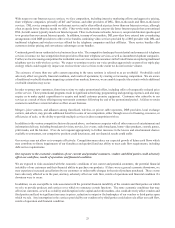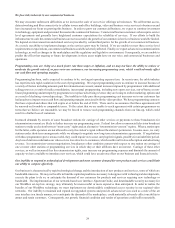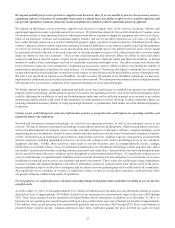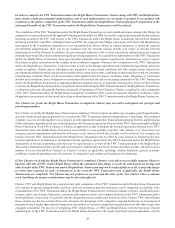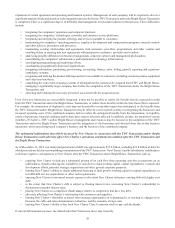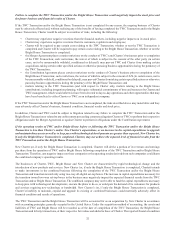Charter 2015 Annual Report Download - page 38
Download and view the complete annual report
Please find page 38 of the 2015 Charter annual report below. You can navigate through the pages in the report by either clicking on the pages listed below, or by using the keyword search tool below to find specific information within the annual report.23
With respect to our Internet access services, we face competition, including intensive marketing efforts and aggressive pricing,
from telephone companies, primarily AT&T and Verizon, and other providers of DSL, fiber-to-the-node and fiber-to-the-home
services. DSL service competes with our Internet service and is often offered at prices lower than our Internet services, although
often at speeds lower than the speeds we offer. Fiber-to-the-node networks can provide faster Internet speeds than conventional
DSL, but still cannot typically match our Internet speeds. Fiber-to-the-home networks, however, can provide Internet speeds equal
to or greater than our current Internet speeds. In addition, in many of our markets, DSL providers have entered into co-marketing
arrangements with DBS providers to offer service bundles combining video services provided by a DBS provider with DSL and
traditional telephone and wireless services offered by the telephone companies and their affiliates. These service bundles offer
customers similar pricing and convenience advantages as our bundles.
Continued growth in our residential voice business faces risks. The competitive landscape for residential and commercial telephone
services is intense; we face competition from providers of Internet telephone services, as well as incumbent telephone companies.
Further, we face increasing competition for residential voice services as more consumers in the United States are replacing traditional
telephone service with wireless service. We expect to continue to price our voice product aggressively as part of our triple play
strategy which could negatively impact our revenue from voice services to the extent we do not increase volume.
The existence of more than one cable system operating in the same territory is referred to as an overbuild. Overbuilds could
adversely affect our growth, financial condition, and results of operations, by creating or increasing competition. We are aware
of traditional overbuild situations impacting certain of our markets, however, we are unable to predict the extent to which additional
overbuild situations may occur.
In order to attract new customers, from time to time we make promotional offers, including offers of temporarily reduced price
or free service. These promotional programs result in significant advertising, programming and operating expenses, and also may
require us to make capital expenditures to acquire and install customer premise equipment. Customers who subscribe to our
services as a result of these offerings may not remain customers following the end of the promotional period. A failure to retain
customers could have a material adverse effect on our business.
Mergers, joint ventures, and alliances among franchised, wireless, or private cable operators, DBS providers, local exchange
carriers, and others, may provide additional benefits to some of our competitors, either through access to financing, resources, or
efficiencies of scale, or the ability to provide multiple services in direct competition with us.
In addition to the various competitive factors discussed above, our business competes with all other sources of entertainment and
information delivery, including broadcast television, movies, live events, radio broadcasts, home video products, console games,
print media, and the Internet. If we do not respond appropriately to further increases in the leisure and entertainment choices
available to consumers, our competitive position could deteriorate, and our financial results could suffer.
Our services may not allow us to compete effectively. Competition may reduce our expected growth of future cash flows which
may contribute to future impairments of our franchises and goodwill and our ability to meet cash flow requirements, including
debt service requirements.
Our exposure to the economic conditions of our current and potential customers, vendors and third parties could adversely
affect our cash flow, results of operations and financial condition.
We are exposed to risks associated with the economic conditions of our current and potential customers, the potential financial
instability of our customers and their financial ability to purchase our products. If there were a general economic downtown, we
may experience increased cancellations by our customers or unfavorable changes in the mix of products purchased. These events
have adversely affected us in the past, and may adversely affect our cash flow, results of operations and financial condition if a
downturn were to occur.
In addition, we are susceptible to risks associated with the potential financial instability of the vendors and third parties on which
we rely to provide products and services or to which we outsource certain functions. The same economic conditions that may
affect our customers, as well as volatility and disruption in the capital and credit markets, also could adversely affect vendors and
third parties and lead to significant increases in prices, reduction in output or the bankruptcy of our vendors or third parties upon
which we rely. Any interruption in the services provided by our vendors or by third parties could adversely affect our cash flow,
results of operation and financial condition.






